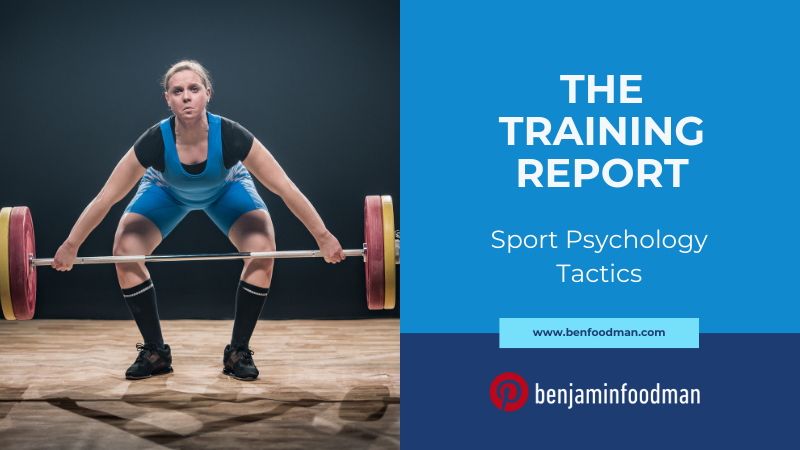Sport Psychology Tactics - IndyCar Drivers And Mental Training
About the Author
Ben Foodman is a licensed psychotherapist & performance specialist. He owns his private practice located in Charlotte North Carolina where he specializes in working with athletes to help them overcome mental blocks (the yips), PTSD, ADD / ADHD and achieve flow states through the techniques of Brainspotting & Neurofeedback. If you are interested in services, use the link here! Enjoy the article below!
Introduction: IndyCar Drivers & Sport Psychology Training
Being located in Charlotte, North Carolina has given me the opportunity to work with many professional racecar drivers. While I originally started working primarily with NASCAR drivers, over the years I have begun to work with professionals who have competed in different racing series such as IndyCar and Rallycross (I have also worked with stunt drivers and car test drivers). While all of these athletes have found training approaches that are unique to their individual bodies and minds, there are consistent training habits that I see in all of these performers. I have also found that these training habits have universal application in other sports environments which is why I wanted to share these strategies.
For this issue of the Training Report I want to review mental training strategies that IndyCar drivers use to enhance their driving performance. For part I. I am going to go into depth as to why IndyCar drivers use mental training in their preparation. For part II. I am going to explore how one part of their mental training involves using exercise psychology strategies to enhance their psychological performance. Finally in part III. I am going to review 2 interventions that I have found to be highly effective for these performers: Brainspotting and Biofeedback. I will describe what Brainspotting and biofeedback are and why IndyCar drivers (as well as other athletes) benefit from incorporating these forms of mental training.
Part I. Why Do IndyCar Drivers Use Mental Training?
When IndyCar drivers experience either continuous stress in the cockpit, or shock trauma events (e.g. car crashes, seeing colleagues crash or become seriously injured), the driver’s brain becomes at increased risk for remaining in a hypervigilant state. In the book This Is Your Brain On Sports by David Grand, the author goes into great detail to explain the neuroscience behind the sports-related stress and how the brain responds to stress events. The author describes as follows ‘In parallel fashion, the brain attempts to always move toward a state of psychological equilibrium. Over the course of our lives, we are exposed to a variety of life experiences, some positive, some neutral, and some negative. Through a natural assimilation process, the brain adaptively processes these experiences so they are constructively integrated. What is useful from the experience is learned and stored in the brain with the appropriate emotion and is available for future use. When an experience is successfully assimilated or digested it is stored in the brain with little attached intense emotion or physical sensation. When we recall such an incident, we don’t reexperience the old emotion or sensation with it. In this way we are informed by our past experiences and memories but not controlled by them and with sports our present athletic performances are not burdened by emotional or physical baggage from the past, only learned experience. By contrast, trauma or any strongly negatively charged experience isn’t adequately assimilated or processed. Instead, the upsetting incident remains stuck in the system in broken pieces’.
The author continues, ‘ The body instantly memorizes the physical experience of the trauma in exquisite detail, including the body sensations of the impact and pain, along with the associated sights, sounds, smells and tastes. The attached emotions and where they are felt in the body are frozen as well. The brain is overwhelmed and instead of getting digested, all of the information attached to the injury, including the negative thoughts is stored in the brain in exactly the same form it was initially experienced. Days, week, months or even years later when the athlete is in a situation reminiscent of the original trauma or experiences prolonged stress, the upsetting experience may be unconsciously activated, thus interfering with the performance of the moment. These components represent all of the sensory details from the earlier event that were frozen in the brain and body in their original disturbing state: the images, lighting, emotions, physical movements, sounds, or smells. The unique sensory details later returning to consciousness cause the performance disrupting symptoms so common in mental blocks.’ So keeping in mind that the brain has a predictable set of mechanisms that will be activated once the athlete has exceeded their stress-threshold capacity, athletes need to do everything possible to mentally train themselves to avoid psychological setbacks. In my experience working with motorsports athletes, it’s not a matter of If but WHEN. So what are some full-proof mental training strategies that IndyCar drivers use that other athletes could benefit from?
Part II. IndyCar Drivers Mentally Train With Exercise Psychology
Exercise psychology training is quickly becoming one of the smartest tools available for sport psychologists to use. One of those strategies that I utilize when working with IndyCar drivers and performers in other series is Prehab. There are many different definitions and interpretations of what ‘prehab’ is. In the book The 4-Hour Body by Timothy Ferris the author quite simply defines prehab as ‘injury-proofing- the body. You could make the argument that all strength & conditioning is ‘injury-proofing’ the body, but when speaking with different exercise science professionals and biomechanists, most of these individuals consider prehab to be a combination of strength training with physical-therapy style focused exercises. In Mr. Ferris’s book, he provides an example of how prehab specialists think about this issue: According to Gray the most likely cause of injury is neither weakness nor tightness, but imbalance. Think doing crunches or isolated ab work is enough to work your core muscles? Think again. ‘The core, as just one example, often works find as long as one’s hips aren’t moving. It’s when the hips are moving-a more realistic scenario-that the core starts to compensate for left-right differences.’ That’s when you get injured.
Other experts in the field provide similar content to support the need to focus on these types of interventions. In the book Becoming A Supple Leopard by Dr. Kelly Starrett, the following excerpt provides additional rational for this type of thinking: Prioritizing spinal mechanics is the first and most important step in rebuilding and ingraining functional motor patterns, optimizing movement efficiency, maximizing force production, and avoiding injury. In order to safely and effectively transmit force through your core and into your extremities, you need to organize your spine in a neutral position and then crease stability throughout that organized system by engaging the musculature of your trunk, which is knowns as bracing. This is the basis of midline stabilization and organization. To oversimplify this, if you are a professional racecar driver and your body is in pain, aching or your HRV is not in a good state, your mental focus will be compromised and you will have a lot of disappointing performances. Selecting physical training approaches that are both ‘mental specific’ and ‘sport specific’ will enhance psychological performance outcomes in the car. Outside of prehab, what are other mental training approaches that IndyCar drivers would benefit from? Let’s explore the power of Brainspotting and biofeedback.
Part III. Brainspotting & Biofeedback For IndyCar Drivers
Brainspotting is a brain-based psychotherapy technique that utilizes the client’s field of vision to identify unresolved psychological issues. In Brainspotting we say ‘where you look affects how you feel’ and through this process clients have the ability to access the parts of their brain that traditional psychotherapy approaches such as cognitive behavioral therapy are unable to do. This results in clients being able to directly address the true ‘underlying’ issue (which we refer to as a Brain Spot) that has created conflict allowing individuals to move from needing to constantly cope, to not needing to cope at all. Brainspotting can be used to help anyone who is dealing with mental blocks, the yips, psychologically traumatic events, chronic pain issues from injuries, as well as individuals who are trying to access deeper levels of creativity or cultivating mental flow states. When we think about the potential issues that racecar drivers deal with such as concussions, TBIs, car crashes, witnessing colleagues crash, sport humiliations, sports-injuries, out of sport trauma (e.g. car accidents, interpersonal relationship issues), it can be easy to see why this intervention pair perfectly with this athlete population.
The goal of all psychotherapy interventions are to help clients move from dysregulation to regulation. For instance if you are a racecar driver and you have been experiencing mental blocks such as increased pre-performance anxiety or fear responses (misreading if the car is too tight or loose), this can be considered a state of dysregulation. Because almost half of the brain is dedicated to vision, we use the client’s field of vision combined with focused mindfulness to help engage the regions of the brain that are responsible for regulation and bypass the regions that are not! This physiological approach can help clients achieve their desired psychological outcomes. When athletes work with a sport psychologist who uses Brainspotting, they will first identify what the issue is that they would like to resolve. Clients discuss the issue in-depth and then the sport psychologist invites clients to have their eyes follow a pointer that the clinician will move in certain directions to identify the eye position that is relevant to the topic that the client is looking to resolve. Once the eye position is identified, the client will hold that eye position for either several minutes up to two hours potentially until the issue is resolved.
Biofeedback training is another form of mental training that drivers use. One specific benefit that comes from biofeedback training involves improved HRV. Typically when training HRV from a sport psychology perspective, we tend to focus on the larger impact that the autonomic nervous system has on athlete’s mental performance. Dr. Stephen Porges, one of the more well-known experts within the field has made groundbreaking discoveries and provided excellent descriptions about how this system works. Per his website, the following quote illustrates important characteristics of this system, “The mind and body are connected through the Vagus nerve, the longest nerve in the autonomic nervous system, stretching from the brainstem to the colon. It is our internal control center, allowing the brain to monitor and receive information about many of our bodily functions”. We know from research that if left unchecked, athletes and other individuals with low HRV have issues associated with mortality, myocardial infarction, coronary heart disease, and congestive heart failure. When sport psychologists help enhance HRV, HRV in this case is associated with improved autonomic nervous system balance. Research on athlete populations shows that when these benefits are gained, athlete sport performance outcomes improve while also reducing the risk of complex motor skills from being compromised.
Biofeedback is a technique by which sport psychologists monitor and display what is happening in the athlete’s mind and their body’s physiological reactions. There are several different traits that sport psychologists and mental performance consultants can focus on in order to help the athlete with this technology. In the book Biofeedback & Neurofeedback Applications In Sport Psychology edited by Benjamin Strack, PhD, Michael Linden, PhD & Vietta Wilson, PhD, the authors give examples of where Biofeedback technology is used.
Heart Rate: Elevated heart rate may increase reaction time, while stabilization of heart rate may increase endurance, and cardiovascular efficiency.
Respiration - Improper respiration may lead to performance inefficiency or ‘choking’ and hyperventilation.
Muscular Tension - Excess muscle tension can inhibit movement speed, rhythm, timing & flexibility.
Sweaty Palms - An indirect measure of emotional reactivity and anxiety
Brainwave Activity - Athletes who learn to control brainwaves can enhance their ability to pay attention, control their emotions, and minimize a busy brain.
Peripheral Body Temperature - Measures blood flow or blood-vessel constriction in the hands and feet. Stress can cause the constriction or shutting down of blood flow, which inhibits recovery from strenuous workouts or minor and major injuries.
Usually when an athlete works with a sport psychologist during an actual biofeedback session, the athlete will have various sensors attached to different areas of the body. These sensors can range from clips attached to their ears, electrodes attached to their head, or patches attached to their skin (there are no needles, there is no invasive aspect to the procedure). These sensors will relay the information that they are detecting from the body to a computer, the computer will analyze the information (e.g. heart rate, body temperature, etc.) and then display what is actually happening in the athlete’s body during this feedback, while also providing information about when optimal body changes are occurring, which can come in the form of some type of reward (e.g. bell ringing, movie playing, etc.).
The biofeedback HRV sessions accomplish performance gains through various forms of deep breath work. When people talk about the mind-body connection, they are oftentimes referring to how synchronized our bodies are with our brains during performance outcomes. The heart-brain connection is one of the most significant connections athletes can train. There are several reasons for this. First, the heart is what drives our autonomic nervous system (sympathetic nervous system is the gas, i.e. fight or flight, where the parasympathetic is the brakes, i.e. more calms states). During motorsports athletes are exposed to high pressure situations which place an incredible amount of stress on our bodies and minds. This stress can oftentimes increase sympathetic nervous system activity, which can actually be a good thing for sports performances. Sympathetic nervous system activity can sharpen our focus and speed up decision making…but not without a cost. By regularly engaging in Biofeedback training, you can train your brain and body to enhance your endurance, which in turn will reduce your calorie burn, and by extension allow you to make better decisions the deeper into the race you get. The more calories you burn, the worse your decision making gets as time goes on. The calmer you can stay, the better your decisions will be as you get closer to the finish line!
Note To Reader:
If you are an athlete reading this segment of the TRAINING REPORT, hopefully this content was helpful! I put the Training Report together because I felt like many of the discussions on issues such as the Yips/mental blocks, strength training & other subject matter on athlete performance concepts were really missing the mark on these ideas (e.g. how trauma is the direct cause of the Yips). If you are interested in learning more, make sure to subscribe below for when I put out new content on issues related to sport psychology & athlete performance! Also, if you are looking to work with a mental performance specialist, you are in the right place! USE THIS LINK to reach out to me to see if my services are the right fit for your goals!
ARE YOU ON THE LIST?
Make sure you’re signed up to Ben’s mailing list to receive news & updates on new strategies in sport psychology, upcoming workshops & products. Don’t wait, sign up now!




















































































